Abstract: Brown rot produced by Monilinia fructicola (mon) is the main disease that causes postharvest losses in peaches of Argentina. There is a public concern in reducing the use of synthetic fungicides. The objective of this work was to evaluate the effect of lemon essential oil (lo) and aqueous garlic extract (ge) on mon in vitro mycelial growth inhibition (inh). In a first trial a mon colony disc was placed in the middle of a Petri dish containing pda 2%, or over the plate lid containing 1 mL of the following treatments: Control, lo 0.5%, lo 1%, lo 3% and Fludioxonil 0.02%. In a second trial, ge was obtained processing fresh garlic (cultivar Colorado) in a blender with tap water; 1 mL of garlic extract was placed in the cover of each plate, the treatments were: Control, ge 2.27%, ge 5.68%, ge 11.35% and Fludioxonil 0.02%, the mon colony was placed over the lid containing the extract. All concentrations of lo assayed and ge 11.35% showed inh > 90%. Following these results lo and ge could be evaluated in future trials as postharvest treatments on peach fruits for Monilinia fructicola control.
Keywords: Prunus persica, brown rot, peach, alternative compounds, organic production.
Resumen: La podredumbre morena, causada por Monilinia fructicola (mon), es la principal enfermedad causante de pérdidas de postcosecha en duraznos de la Argentina. Existe preocupación por reducir el uso de fungicidas de síntesis química. El objetivo de este trabajo fue evaluar el efecto del aceite esencial de limón (lo) y el extracto acuoso de ajo (ge) sobre la inhibición (inh) del crecimiento micelial in vitro de mon. En un primer ensayo, se colocó un disco de colonia en el centro de una placa de Petri con medio pda 2 %, o sobre la tapa de una placa de Petri conteniendo 1 mL de los siguientes tratamientos: Control, lo 0,5 %, lo 1 %, lo 3 % y Fludioxonil 0,02 %. En un segundo ensayo, se preparó el extracto de ajo licuando ajo fresco (cultivar Colorado) en agua; 1 mL de extracto se colocó sobre la tapa de la placa de Petri, los tratamientos fueron: Control, ge 2,27 %, ge 5,68 %, ge 11,35 % y Fludioxonil 0,02 %. Todas las concentraciones de lo y ge 11,35% produjeron una inh > 90 %. Según estos resultados, lo y ge podrían ser evaluados en futuros ensayos como tratamientos de postcosecha a duraznos para el control de Monilinia fructicola.
Palabras clave: Prunus pérsica, podredumbre morena, durazno, productos alternativos, producción orgánica.
Resumo: A podridão parda, causada por Monilinia fructicola (MON), é a principal doença que causa perdas pós-colheita em pêssegos na Argentina. Existe preocupação na redução do uso de fungicidas de síntese química. O objetivo deste trabalho foi avaliar o efeito do óleo essencial de limão (LO) e do extrato aquoso de alho (GE) na inibição (INH) do crescimento micelial in vitro de MON. Em um primeiro experimento um disco de colônia foi colocado ao centro de uma placa de Petri com meio BDA a 2% ou na tampa de uma placa de Petri contendo 1 mL dos seguintes tratamentos: Controle, LO 0,5%, LO 1%, LO 3% e Fludioxonil 0,02%. Em um segundo experimento o extrato de alho foi preparado por liquidificação de alho fresco (cultivar Colorado) em água; 1 mL de extrato foi colocado na tampa da placa de Petri, os tratamentos foram: Controle, GE 2,27%, GE 5,68%, GE 11,35% e Fludioxonil 0,02%. Todas as concentrações de LO e GE 11,35% produziram uma INH >90%. De acordo com esses resultados, LO e o GE poderão ser avaliados em ensaios futuros como tratamentos pós-colheita de frutos de pêssego para o controle de Monilinia fructicola.
Palavras-chave: Prunus pérsica, podridão parda, pêssego, produtos alternativos, produção orgânica.
Plant protection
In vitro effect of lemon essential oil and garlic extract on Monilinia fructicola growth
Efecto in vitro del aceite de limón y el extracto de ajo sobre el crecimiento de Monilinia fructicola
Efeito in vitro do óleo de limão e extrato de alho no crescimento de Monilinia fructicola
Received: 27 July 2020
Accepted: 24 August 2020
Published: 06 April 2021
Corresponding author: mitidieri.mariel@inta.gob.ar

Brown rot produced by Monilinia fructicola (Wint.) Honey (mon) is the main disease producing yield and quality losses in peaches of San Pedro (Buenos Aires, Argentina) and in other countries (Figure 1)(1)(2). There is a public concern in reducing the use of synthetic fungicides, and several experiences have been conducted in order to study the effect of alternative compounds on postharvest pathogens(3)(4)(5).
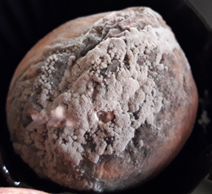
Essential
Essential oils, also called natural volatiles, have a complex composition containing alcohols, aldehydes, ketones, phenols, esters, ethers, and terpenes in varying proportions. Some of these compounds are recognized as “Generally regarded as safe” (gras) chemicals, stimulating interest from postharvest scientists. In vitro studies in the vapor phase have revealed that the application of the essential oils as vapors was highly effective for the control of postharvest pathogens(6).
Essential oils from different species have been assayed for Monilinia fructicola control. Lemon myrtle (Backhousia citriodora) essential oil and citral were effective treatments to control mycelial growth of M. fructicola(7). Other species with essential oils effective against mon are Eugenia caryophyllata, Cinnamomum zeylanium and Carum copticum(8), tea tree (Melaleuca alternifolia)(3)(4), savory (Satureja montana), and Thymus vulgaris(9)(10).
In vitro and in vivo testing were carried out using essential oils in the vapor phase as a fumigant rather than by direct contact, as this application method seemed to be more practical for postharvest disease management(11).
Fumigation with natural volatiles is promising specially in some species, like cherries, because they can be applied without wetting the fruit. The treatment of 10 mg L-1 thymol fumigation significantly reduced the incidence of brown rot, but had no effect on blue mold rot(9) and produced stem discoloration.
Results from the sensory evaluation trials after fumigation indicated that lemon myrtle essential oil treatment effect on sensory value was not significant. The association between lemon myrtle essential oil treatment and intention to purchase was also not significant(11).
A commercial formulate containing essential oil of Melaleuca alternifolia was effective at controlling in vitro growth of Monilinia fructicola(3). This organic formulate proved to be useful in a spraying schedule, combined with fungicides and coadjutants, in order to reduce the application of synthetic products prior to peach harvest(12)(13).
The effect of biofumigation, through slow-release diffusors, of thyme and savory (Satureja montana) essential oils was effective in controlling postharvest rots of peaches and nectarines. Naturally contaminated peaches and nectarines were exposed to eo vapors for 28 days at 0 ºC in sealed storage cabinets and then exposed at 20 ºC for 5 days during shelf-life in normal atmosphere, simulating retail conditions. Under low disease pressure, most treatments significantly reduced fruit rot incidence during shelf-life, while under high disease pressure only vapors of thyme essential oil at the highest concentration tested (10% v/v in the diffusor) significantly reduced the rots(10).
Citrus sinensis essential oil contains limonene; this active compound showed a potent toxicity against Penicillium expansum(14). Citrus industry is a big scale activity in Argentina and lemon essential oils can be obtained as a residue.
Garlic production is important in Argentina and aqueous garlic extract (ge) is obtained, commercialized and applied in different horticultural crops in order to prevent diseases and insect damage. ge contains bioactive compounds as allicin with toxic effects on several pathogens like M. fructicola(15)(16), Aspergillus sp(17), Botrytis cinerea, Colletotrichum sp.(18). Rhizoctonia sp., Fusarium sp. and Sclerotium sp.(19).
The objective of this work was the in vitro evaluation of the effect of lemon essential oil and aqueous garlic extract on Monilinia fructicola growth inhibition (inh).
Monilinia fructicola strains 345 and 350 obtained from peach orchards of San Pedro were grown in pda media 2% with antibiotics until they occupied all the Petri dishes. The incubation was carried out at 24 ºC and the mycelial growth was evaluated 7 days after the beginning of the experience.
All experiments were repeated twice (Rep1 and Rep2), and each treatment consisted of four replicates.
The inhibitory effect of the extracts was determined as a percentage of inhibition of radial growth of mycelium of each treatment with respect to pda control.
Lemon essential oil (lo) was provided by Citrus San Miguel (Tucumán, Argentina). In Experiment 1 a mon (strain 345 and 350) colony disc of 9 mm of diameter was placed in the middle of Petri dishes containing pda 2% according to the following treatments: 1) Control, 2) lo 0.5%, 3) lo 1%, 4) lo 3% and 5) Fludioxonil (flu) 20 mL hL-1 23% suspension concentrate (sc). In Experiment 2, 1 mL of each dilution of the lemon essential oil was placed in the middle of the plate lid, and the colony of Monilinia fructicola strain 345 was located over it.
Aqueous garlic extract (ge) was obtained processing 350 g of garlic (cultivar Colorado) in a blender with 700 mL of tap water. The volume (830 mL) of filtered extract was added with the same quantity of water. 1 mL of the treatment's suspension was placed in the middle of a cover of plates with a disc of mon (strain 345) colony of 7 mm of diameter. Treatments were: 1) Control, 2) ge 2.27%, 3) ge 5.68%, 4) ge 11.35%, and 5) Fludioxonil 20 mL hL-1 23% sc (Figure 2).
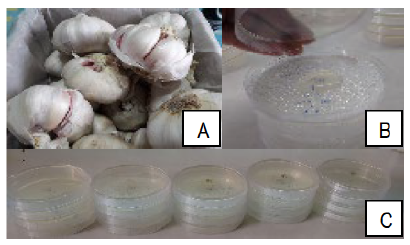
Data were analyzed by one-way Anova using sas program. Duncan multiple media (p≤0.05) test was performed for media comparison.
Experiment 1. Essential lemon oil added to culture media pda reduced M. fructicola growth at percentages higher than 90% in all cases and was so effective as the synthetic fungicide fludioxonil (Figure 3). Statistical differences between treatments were observed only in one repetition with strain 350 (R2= 0.95, cv= 2.30, Media= 88.52). Concentrations of 1 and 3% showed inh values of 100% for both strains and all repetitions.
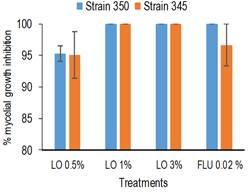
*Media of two repetitions; FLU= Fludioxonil added to growth media. Vertical bars indicate means standard error
The in vitro inhibitory effect of lo added to pda culture media was important, and differences between lo concentrations and chemical control were not important. lo concentrations of 1 and 3% seemed to be more promising.
Experiment 2. Highly statistical differences between treatments were observed in both repetitions (Rep1: R2= 0.78, cv=25.76, Media= 68.49; Rep 2: R2 0.91, cv= 21.39, Media= 62.07). Essential lemon oil at 3% placed under the colony of M. fructicola reduced the fungus growth at percentages of 100% and was so effective as the synthetic fungicide fludioxonil added to the culture media. Concentrations of lo of 0.5% and 1% showed lower inhibitory effects (Figures 4 and 5).
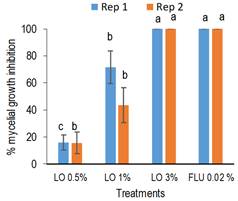
*Rep = experiment repetition; FLU= Fludioxonil added to growth media. Media with different letters significantly differ for Duncan test (p≤0.05). Vertical bars indicate means standard error

*From left to right: Control, LO 0.5%, LO 1%, LO 3% and fludioxonil added to growth media
lo at 0.5% and 1% added to media was more effective reducing M. fructicola growth than applied on the Petri dish plate. According to advances in postharvest disease control, fumigation with natural volatiles is a technique that could be used for reducing synthetic fungicide application to fruits. lo at 3% should be considered for further fumigation trials with peach fruits.
M. fructicola colonies placed over 1 mL of aqueous garlic extract were inhibited by all ge dilutions. Statistical differences (p≤0.01) were obtained only at Rep 2 (R2= 0.96, cv=14.71, Media= 44.18). ge 11.35% showed inh > 90% in both repetitions (Figures 6 and 7). The low inhibitory effect of Fludioxonil can be explained by the fact that it was applied on the Petri dish plate, and not added to the culture media.
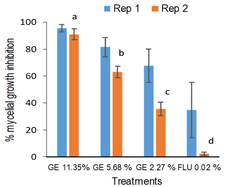
*Rep = experiment repetition; FLU= Fludioxonil. Media with different letters significantly differ for Duncan test (p≤0.05). Vertical bars indicate means standard error

*From left to right: Control, GE 11.35%, GE 5.68%, GE 2.27% and fludioxonil 0.02%.
Following these results, further investigations could be performed to evaluate postharvest fumigation with ge in order to reduce the presence of brown rot in peaches.
Several authors have obtained promising results for the in vitro and in vivo control of brown rot using natural volatiles.
This work shows that lo and ge, both natural products easily obtained in Argentina, can reach over 90% of in vitro mycelial growth inhibition of Monilinia fructicola.
Following these results, lo and ge could be evaluated in future trials as postharvest treatments to peach fruits for Monilinia fructicola control.
Methods of application should be assayed, and further assays developed, in order to evaluate these alternative compounds to synthetic fungicides.
Authors contribution: Mitidieri, M. S. conceived and
designed the analysis; Brambilla, M. V., Barbieri, M. and Piris,
E. collected the data; Mitidieri, M. S. Brambilla, M.
V., Barbieri, M. contributed to data or analysis tools, and performed the
analysis. Mitidieri, M. S.
wrote the paper.
Editors: The following editors approved this article.
Maximiliano Dini (https://orcid.org/0000-0003-1118-7803)
Instituto Nacional de Investigación
Agropecuaria (INIA), Canelones, Uruguay.
Roberto Zoppolo
(https://orcid.org/0000-0003-3063-0196)
Instituto Nacional de Investigación
Agropecuaria (INIA), Canelones, Uruguay.
http://agrocienciauruguay.uy/ojs/index.php/agrociencia/article/view/403/703 (pdf)
The experiments were carried out with the funding of inta projects. Thanks to agricultural engineer Guillermo Torres Leal from inta eea Famaillá, Tucumán, Argentina, who generously provided de lemon essential oil.
mitidieri.mariel@inta.gob.ar



*Media of two repetitions; FLU= Fludioxonil added to growth media. Vertical bars indicate means standard error

*Rep = experiment repetition; FLU= Fludioxonil added to growth media. Media with different letters significantly differ for Duncan test (p≤0.05). Vertical bars indicate means standard error

*From left to right: Control, LO 0.5%, LO 1%, LO 3% and fludioxonil added to growth media

*Rep = experiment repetition; FLU= Fludioxonil. Media with different letters significantly differ for Duncan test (p≤0.05). Vertical bars indicate means standard error

*From left to right: Control, GE 11.35%, GE 5.68%, GE 2.27% and fludioxonil 0.02%.

